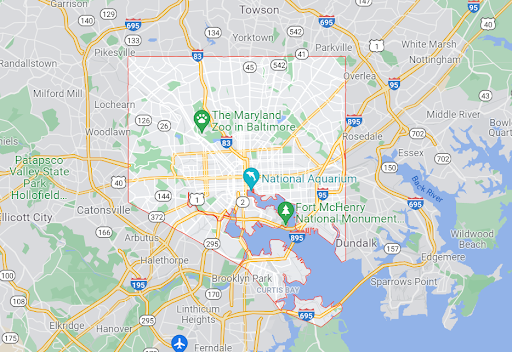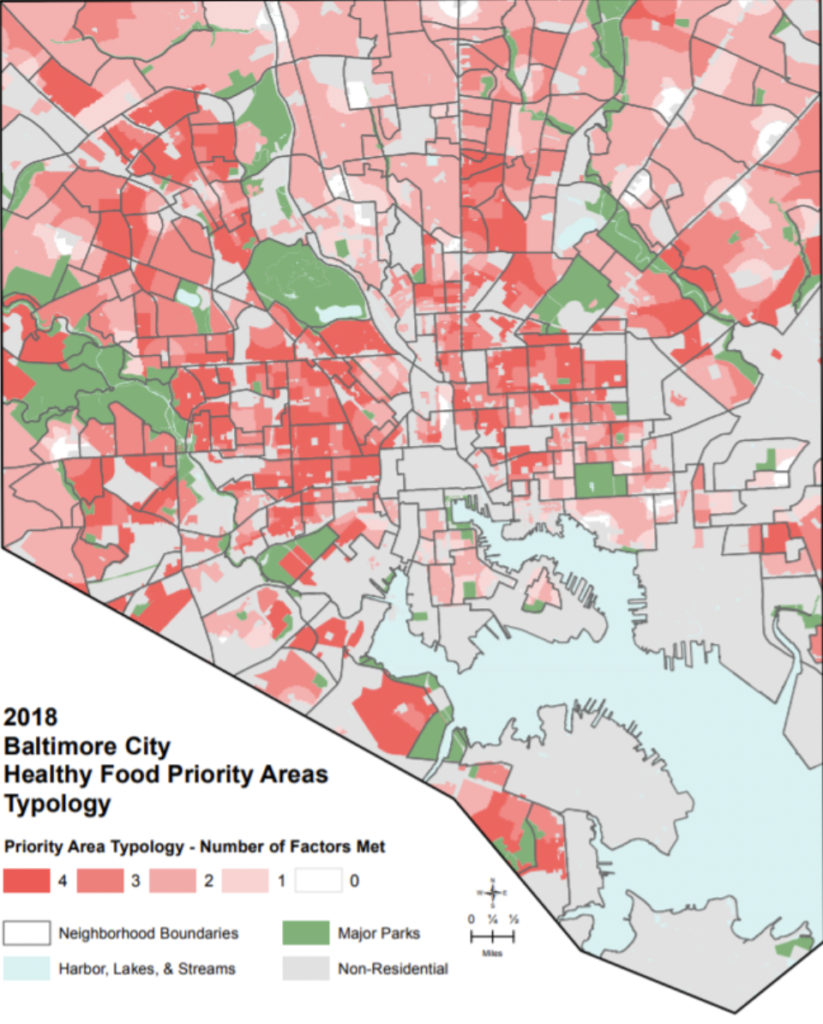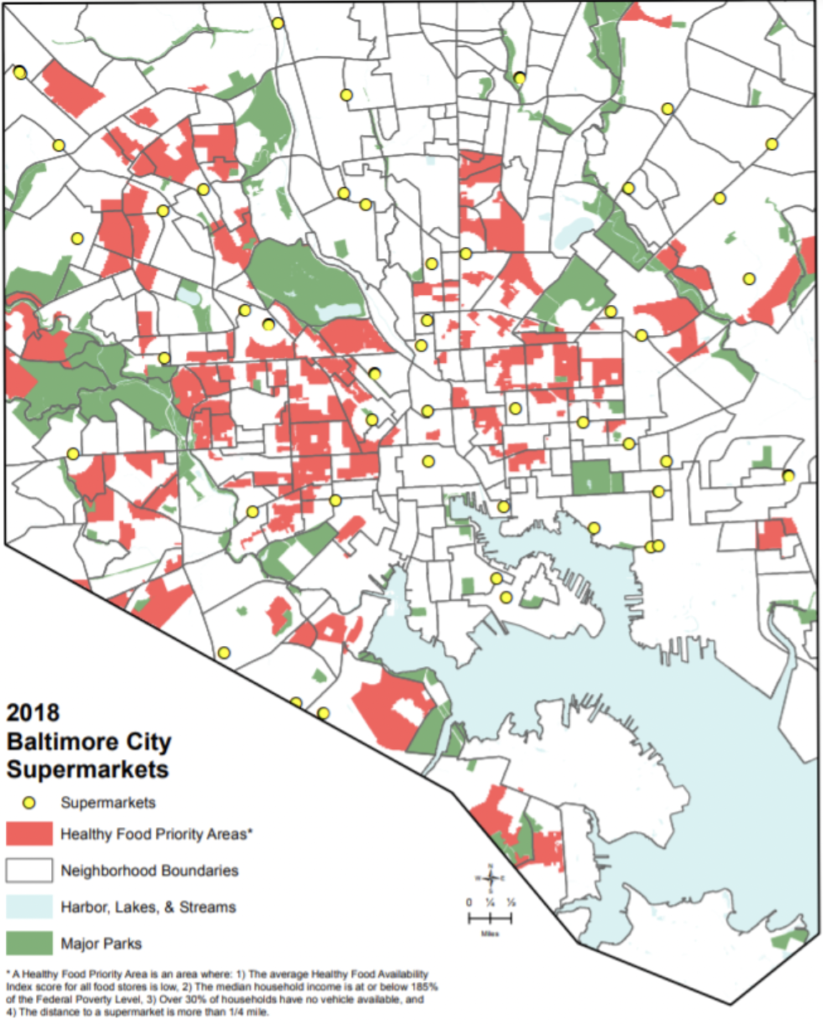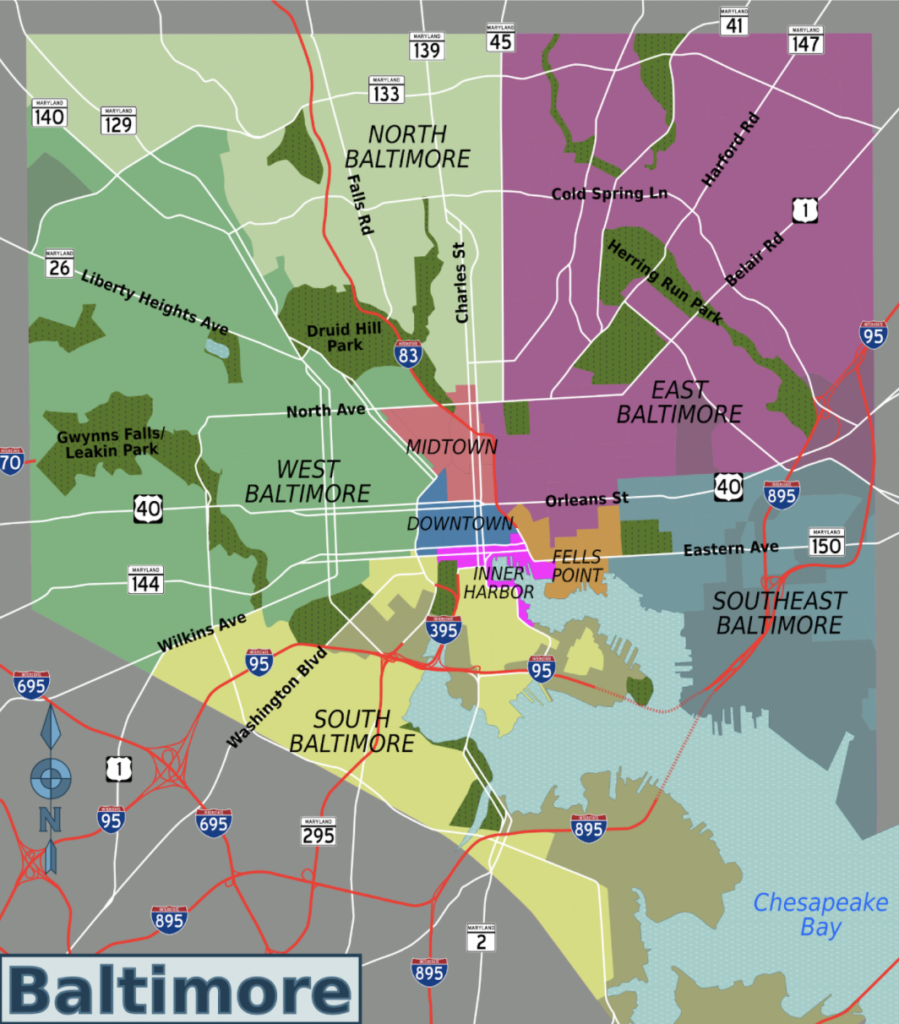What Is A Food Desert?
A food desert is a geographical area where it is difficult to buy healthy, nutritious food at an affordable price. Food deserts include areas where travel to a grocery store is difficult, and in areas where healthy food may be available, but at an unaffordable price.
Baltimore, like many other cities in the U.S., has several areas that are considered food deserts.
Learn more: What Are Food Deserts?
Fast Facts About Food Deserts in Baltimore
- 144,300 people in Baltimore experience food insecurity, meaning they don’t have access to enough or healthy enough food (Baltimore City’s Food Environment 2018 Report). This includes 30,000 children in Baltimore.
- 23.5% of people in Baltimore live in food deserts. This number is higher among children; 28.3% of children in Baltimore live in food deserts (Baltimore City’s Food Environment 2018 Report)
- Baltimore has the highest poverty rate in Maryland (Maryland Alliance for the Poor).
Why Are There Food Deserts In Baltimore?
Food deserts are a socio-economic problem that tend to occur in specific neighborhoods as a result of a lack of proper aid and investment in that neighborhood.
Food deserts are found in Baltimore in neighborhoods with high poverty levels. These areas have lower access to transportation, making it more difficult to get to a grocery store.
Food deserts are also disproportionately found in areas where the residents have lower levels of education and high unemployment rates. Areas with food deserts also have high rates of abandoned or vacant buildings.
Food deserts are more likely to occur in primarily Black communities in Baltimore. A national 2014 study showed that even in areas of equal poverty, Black communities are less likely than communities of other races to have access to grocery stores and fresh food (Bower et al. 2014).
Where Are There Food Deserts In Baltimore?
Areas in Baltimore with low-income and low-access to stores, as well as low vehicle access are food deserts.
This map provides an overview of where food deserts are located in the city of Baltimore and surrounding areas. Any area showing green or orange is a food desert. These areas closely overlap with low-income areas.

The map below provides a more zoomed-in view of food deserts in Baltimore by community area. The Baltimore Health Department and Johns Hopkins created this map by overlaying four definitions of food deserts.

Health Department and Johns Hopkins created this map by overlaying four definitions of food deserts.
Areas of high priority (dark red) match all four of these conditions, meaning the area is a food desert.
The City of Baltimore defines food deserts (referred to as “Healthy Food Priority Areas” or HFPAs) in Baltimore as an area that meets all four of these factors:
- An area where the distance to a supermarket or supermarket alternative is more than ¼ mile
- The median household income is at or below 185% of the Federal Poverty Level
- Over 30% of households have no vehicle available
- The average Healthy Food Availability Index (HFAI) score for all food stores is low (Baltimore City Health Department).
Food deserts also occur more frequently in primarily Black neighborhoods. Black residents are the most likely of any racial group in Baltimore to live in a food desert (31.5% Black residents live in a food desert), while only 8.9% of white residents live in food deserts (Baltimore City’s Food Environment 2018 Report).
Lastly, in food desert areas in Baltimore, there are many more convenient stores and fewer grocery stores than in other areas. For example, there are 177 convenience stores located in food deserts in Baltimore, while there are only 6 convenience stores located outside of food deserts (Baltimore City’s Food Environment 2018 Report).
It is clear from the map below that grocery stores (yellow dots) are mainly located outside of food deserts (red).
Solutions
The first step in disrupting food deserts in Baltimore is researching where food deserts exist. The City of Baltimore Health Department created reports in 2015 and 2018 that comprehensively reviewed food access in the city, creating maps of high priority areas and offering solutions.
Many of these solutions have begun being implemented in recent years.
Increased Number of Farmers Markets
Farmers Markets are a good example of a local, community-based solution to bring fresh food to food deserts.
Not only will increasing the amount of farmers markets increase healthy food access, but so will providing financial aid to farmers market shoppers.
For example, the Maryland Market Money Program matches up to $5 of purchases for families that use federal nutrition benefits at farmers markets. This incentivizes families in food deserts to shop at farmers markets and allows them to buy more food with limited income.
Increased Access To Vehicles And Other Public Transportation Systems
In addition to creating more healthy food options locally, increasing transportation options can help reduce food deserts.
One method to increase transportation to grocery stores is to build up better public transportation. This may include adding a bus stop or even creating a shuttle system within the town.
Additionally, Lyft ride sharing created the Grocery Access Program to discount the cost of rides to grocery stores. This program has been piloted successfully in Washington D.C. in 2019, and has expanded to Baltimore since then.
Increased Urban Agriculture
Urban farming is growing in Baltimore and provides increased access to locally grown fresh fruits and vegetables. The best example of urban farming in the city is Homegrown Baltimore, a Baltimore Office of Sustainability program that focuses on growing local healthy food, buying local, and eating local.
Community gardens also offer homegrown produce on a smaller scale. As of 2018, there were 100 community gardens in Baltimore, but only 17 of them were located in food deserts. Not only do community gardens help put healthy food on the table, but they also can provide a little extra income to growers; a new 2017 zoning law allows community gardens to set up stands to sell their produce.
Community gardens do require time and input from community members, which can make it more difficult to make gardening a viable solution to food insecurity.
Other Solutions
Other solutions that could help eliminate food deserts in the city of Baltimore include:
- Financial incentives and support for neighborhood-based grocery stores and farmers markets with discounted prices and increased availability of healthy food
- Increased financial assistance for residents of food deserts to buy food
- Increased number of grocery stores in food deserts
- Restrictions on where dollar stores can be, as they displace grocery stores
- Increased public health education to encourage healthy eating
- Increased meal access for children through government-funded after-school meal sites and the Summer Food Service Program
While these solutions have been recognized, many are still in early development stages of implementation.
Case Study: East Baltimore
East Baltimore is a district of Baltimore. It covers about a third of the city, and is mainly residential. The area is home to Johns Hopkins Medical Campus.
East Baltimore is made up of many smaller neighborhoods, many of which experience higher rates of violent crimes than the rest of the city of Baltimore (George 2016).
East Baltimore is shown in purple on the map below.
Many areas of East Baltimore are considered a food desert. This is due mainly to low-incomes and a lack of available healthy food, but is also worsened by low access to transportation.
East Baltimore follows some of the classic characteristics of where food deserts are most commonly found. Compared to the rest of the Baltimore metropolitan area, East Baltimore has lower incomes and a larger non-white community.
- The median income of East Baltimore residents is $38,722, while the median income in the city of Baltimore is $50,177.
- 68.1% of East Baltimore residents are Black compared to 61.8 % of the people in the city of Baltimore. Only 12% of East Baltimore residents are white compared to 27.4% of Baltimore residents. Source
It should be noted that East Baltimore is quite a large area, so not every neighborhood falls in line with general statistics for the area.
Additionally, East Baltimore does not follow all the characteristics of where food deserts are often found. For example, the average number of cars per household (1.8) is actually higher in East Baltimore than in the rest of the city (1.5), although not by a lot.
Many solutions have been suggested to increase East Baltimore residents’ access to healthy food. For example, in 2016, the Save a Lot grocery store opened in East Baltimore, in an area that had no access to any other grocery stores. It has been described as an “oasis” in East Baltimore, contrasting with a food “desert”.
The store opened in this location due to incentives enacted by Baltimore’s Governor Larry Hogan. The Food Desert Retail Incentive plan offers tax breaks and loans to grocery stores that open in food desert areas, and that provide a certain amount of produce and perishable food.
Other solutions beyond a single grocery store are needed to truly address the food deserts in East Baltimore.


